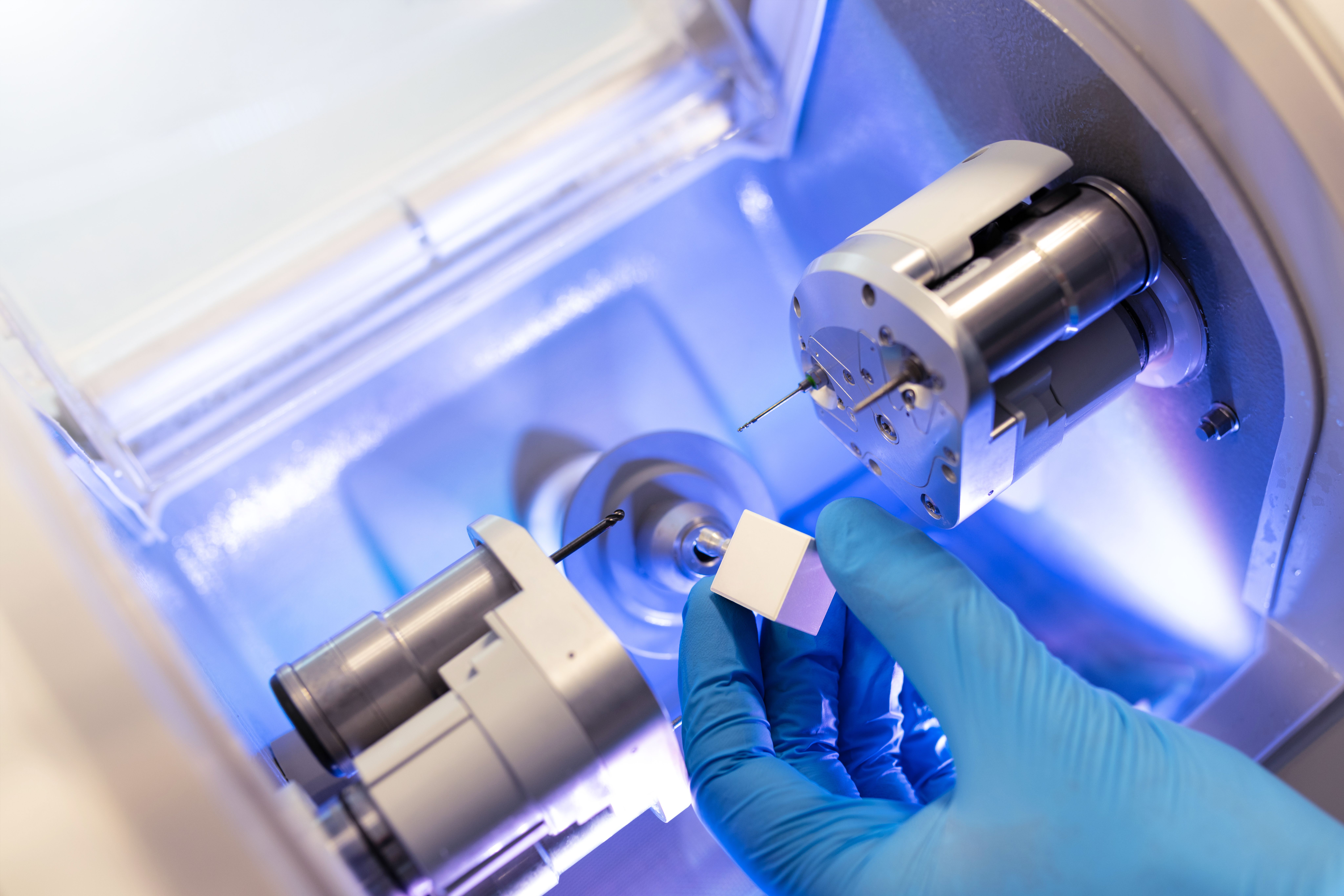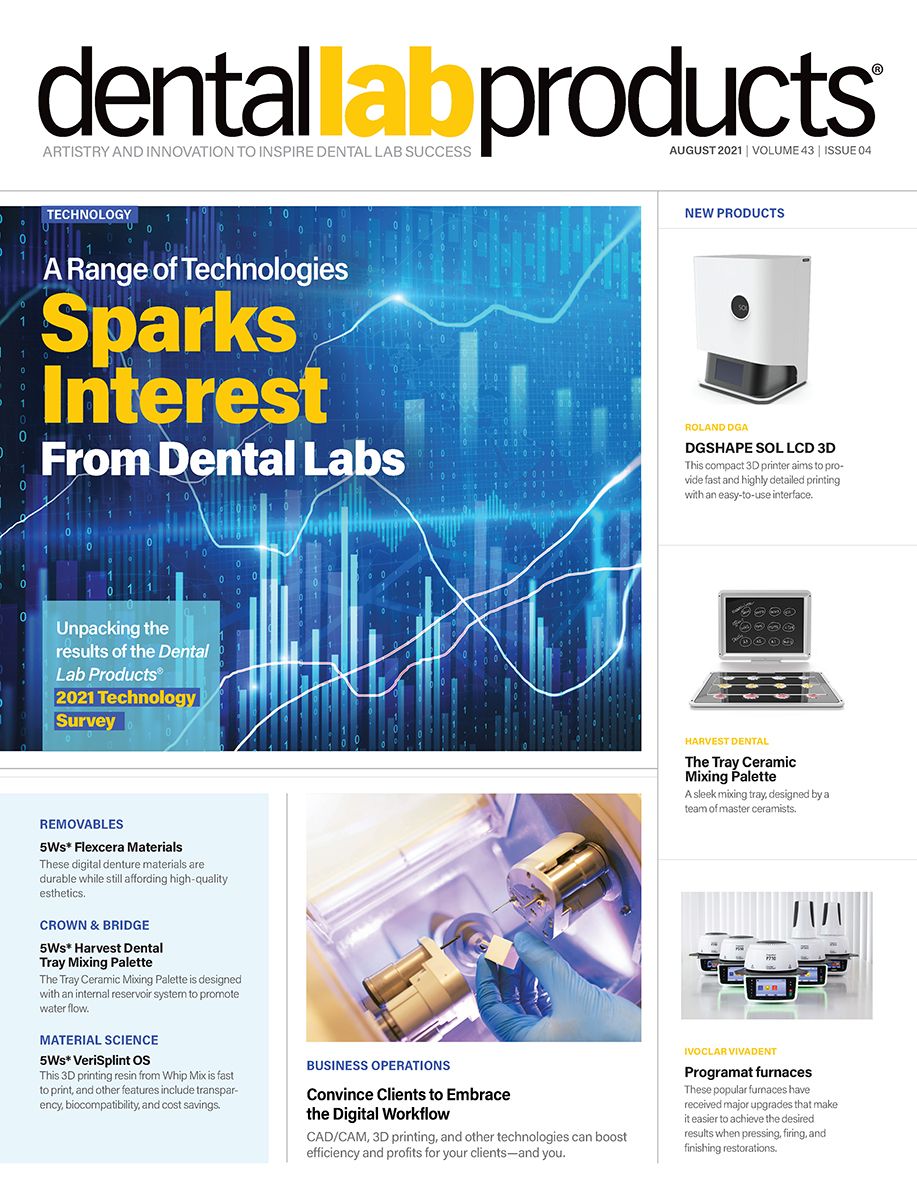Convincing Your Clients to Embrace the Digital Dentistry Workflow
CAD/CAM, 3D printing, and other technologies can boost efficiency and profits for your clients—and you.
By yalcinsonat / stock.adobe.com

Technology is continually improving dentistry, as well as almost every sector of American life. Materials, tools, and techniques have all advanced, thanks to technological advances. For instance, composites supplanted unsightly amalgam. CBCT gives dentists a real-world, 3D representation of a patient’s head. And perhaps most revolutionary for the dentist and laboratory was the advent of CAD/CAM.
Although labs were quick to realize CAD/CAM’s advantages, doctors are not always eager to spend money on something new. The digital workflow is great for labs, because it builds a lot of efficiencies into the process. Although labs are, unquestionably, more efficient with in-house digital processes, those processes are more efficient when their client dentists initiate a case with an intraoral scan. It would be ideal if every lab utilizing a digital workflow had all of its doctors submitting cases digitally, but that isn’t always the case.
There are some strategies that labs can employ to nudge their doctors toward adopting CAD/CAM technology.
Is now the time?
The digital workflow has been around for years, but some dentists may wonder if now is the best time to invest in the technology or if there is still room for improvement and for costs to come down.
“I don’t think there has ever been a better time to embrace digital workflow in dentistry than now,” Naren Rajan, DMD, says. Dr Rajan is the founder of Dentistry of Mendham in New Jersey, assistant director of digital dentistry at the Touro College of Dental Medicine at New York Medical College, and a faculty member at CADpro Academy in Woodbury, New York. “Dentists have more choices than ever before, and the open architecture of modern systems allow them to incorporate whatever level of technology they desire. But also, current systems and workflows allow a dentist to learn and incorporate at their own pace. For instance, they can begin with intraoral scanning then add other digital components such as milling, 3D printing, digital smile design, and more.”
“They really should not wait,” Steve Braykovich, president and CEO of Axsys Dental Solutions in Wixom, Michigan, adds. “We’re past the point of the technology adoption cycle where the technology is largely untested and under constant change and improvement. The newest in technology is typically embraced by early adopters who can afford the risks of very early implementation....Today, the technology and products have been used, tested, and perfected over the course of many years and are now being implemented by the masses. Yes, there’s always room for improvement, however, waiting only delays the inevitable and puts your practice at risk. [Waiting to purchase new technology means] you’ll be unable to compete in terms of quality and cost with practices that have already implemented some part of the digital workflow.”
David Turpin, owner of Spartan Dental Lab in Lansing, Michigan, observes that intraoral scanners are at a fantastic maturation point, and he says now is as good a time as it’s ever going to be to submit cases digitally.
“Many scanners out there are great, probably the best yet,” he says. “I don’t know how much better they can get from where they are now....The materials have come a very long way, too. I even have some doctors who still want gold crowns and PFMs, but they now scan them. We’re able to produce just about every type of restoration from a scan.”
Making the case
What is the best way for labs to appeal to client doctors? Tell the doctors about the digital workflow’s inherent efficiency? Cost savings? Quality? Something else?
“As a dentist interested in using digital workflows for my patients, it really needs to include all 3 benefits,” Dr Rajan says. “This is the promise of digital dentistry, after all, but I would also add predictability. I need the fit and esthetics of the final product to be predictable above all else. I would say money is actually the least important in this list, because if the products are predictably of high quality, delivered efficiently, I am willing to pay a premium, within reason. The cost of remaking something is far more expensive than paying a bit more at the outset.”
Anyone who is in business must look at the money and the bottom line. It is not to suggest that patient care isn’t the doctor’s primary concern, but money matters and that can be an effective way to make the sale.
“I would use the term ‘profitability’ over ‘money,’” Braykovich says. “We focus more directly on reducing patient chair time, reducing revisits due to inaccuracies in what they receive from their lab partners, reducing—not necessarily eliminating—their lab expenses, and gaining control over deliverables and quality.”
For the lab, efficiency encapsulates all of the benefits, particularly the communications benefits, and for Turpin, sharing that with his clients is the best way to encourage them.
“I like to inform my clients about the efficiency of it,” he says. “And not necessarily the efficiency of how fast it is, but the efficiency of how we, as a lab, are able to communicate back to the doctor. I’m able to give [my out-of-town doctors who have scanners] instant feedback or answer any questions about the case. We don’t have to wait for the impression to come in, pour it up, look at it, and call the doctor to have the patient come back in.”
The appeal
It’s one thing to tell dentists that the digital process is more efficient and will save costs. Dentists also may require some proof.
“I think this can be the most difficult part of the process of taking a dentist digital
who hasn’t been digital before,” Dr Rajan says. “Ultimately, the dentist will absolutely need proof of concept. Unfortunately, so much of the success or failure of the process is in the control of the dentist when it comes to using their technology properly. There is an enormous educational void in teaching dentists about digital workflows, how they work, and what the clinical best practices are to ensure success. If a laboratory can provide those tools to a dentist, it can be a win-win for the team.”
One of the ways in which Turpin shows his client doctors the benefits of the digital workflow is by leasing intraoral scanners.
“I do advertise the lease program quite a bit to get curious dentists involved,” Turpin says. “If they’re interested in that program, I have a demo unit and I’ll show them how to use it. I’ll let them try it out for a week or so and tell them there are no strings attached. If they want to purchase one, they can; if they want to lease one, great. If they want a different kind, I encourage them to look into other brands. I want them to be comfortable with their investment to grow their practice.”
Braykovich observes that presenting the solution with a complete look at all facets—both positive and negative—can help persuade client dentists.
“We discuss the current technology and the relative advantages and disadvantages, pros and cons, and what differentiates Axsys Dental Solutions in our offerings and ability to support their operation,” Braykovich says. “Of course, nothing beats references from their peers—existing clients who can candidly explain their decisions and how it has helped their business. Our current doctor clients also educate their peers on the importance of their supplier’s ability to train and support them, something many doctors forget to include in their selection criteria and where we excel.”
Roadblocks
It’s not uncommon for older doctors to be resistant both from workflow and cost points of view.
“I’d say it’s generational in that many doctors are at a point of retirement and not excited about the cost of implementing digital dental technology,” Braykovich says. “Some are concerned it will somehow bring about a disruption in their practice, and many are simply resistant to change or have the fear of the unknown. We find many don’t know what technology is available or the details of the digital dental workflow. Still others find it difficult to secure financing for their technology investment or simply have other needs that they perceive as a higher priority.”
Every dentist is unique, and their needs and professional experiences will factor into their overall decision.
“Typically, the dentists who are able to make the investments in digital technology are not new graduates who have grown up with technology,” Dr Rajan says. “They are dentists well-versed in analog techniques and workflows. I think dentists typically can be resistant to change, and rightfully so. It takes years of clinical of practice to hone restorative techniques and obtain predictable results for our patients. If I were a patient, I would not want my doctor constantly trying new techniques on my mouth. On the other hand, I also would not want my doctor to use outdated techniques when better ones are available....The cost of entry cannot be overlooked, as it does require significant financial investments to begin. [But] there are many built-in cost offsets that make digital dentistry affordable even for small single doctor offices [such as] my own.”
Some of it also depends on the doctor’s willingness to embrace technology.
“Many dentists I’ve spoken with are not always technology- and computer-savvy,” Dr Rajan says. “....There does seem to be a certain level of uneasiness of embracing technology in older generations of dentists, at least anecdotally. Learning digital dentistry does require some trial and error and leaving one’s comfort zone.”
As with any technology, the cost of intraoral scanners continues to decrease, but the equipment can still be pricey, which can be a turn-off for dentists. Turpin explains that, despite the price, when clients look at the whole benefit to their business, they realize the ultimate cost savings.
“Today, one of the hurdles would be the cost of the scanners,” Turpin says. “Some of them are very expensive. However, they are coming down in price. [Dentists will] see the impact it will make on the savings in impression material and how they’re going to maximize efficiencies in chair time.”
Moving forward
Despite the lab’s best efforts, there may be dentists who still refuse to go digital. In some cases, the lab may decide that they can no longer serve that doctor.
“If a dentist simply refuses to embrace digital technology and the laboratory is committed to only using digital workflow from intraoral scans, then I don’t see how the relationship can continue,” Dr Rajan says. “However, for the time being, I do believe laboratories should continue working with dentists who can provide excellent physical impressions where stone casts can be digitized.”
Although he is heavily invested in the digital workflow, Turpin is still happy to work with any of his client doctors regardless of whether they have embraced CAD/CAM.
“We just keep doing as we’ve been doing,” he says. “We’ll continue to accept physical impressions because I don’t see them going away anytime soon.”
Whichever way the lab chooses to go, Braykovich emphasizes the need for tact and discretion.
“This is a very sensitive issue, as we do not want to become a nuisance by interrupting their business with constant phone calls and emails,” Braykovich says. “We typically try to understand their position on implementing our solutions and mutually agree on a time for follow-up. Many doctors grant us permission to notify them of any new events or promotions, as they may be significant enough to influence their decision and timeframe.”
